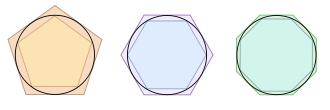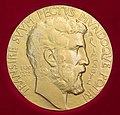connected. These topologies also have interesting separation and homogeneity properties. The notion of an arithmetic progression topology can be generalized...
13 KB (1,732 words) - 07:37, 24 May 2025
x_{\bullet }.} Arithmetic progression topologies The Baire space − N N {\displaystyle \mathbb {N} ^{\mathbb {N} }} with the product topology, where N {\displaystyle...
15 KB (2,036 words) - 16:26, 1 April 2025
Prime number (section Arithmetic progressions)
19th century result was Dirichlet's theorem on arithmetic progressions, that certain arithmetic progressions contain infinitely many primes. Many mathematicians...
117 KB (14,179 words) - 21:25, 8 June 2025
Arithmetic progression – a sequence of numbers such that the difference between the consecutive terms is constant Generalized arithmetic progression –...
14 KB (1,603 words) - 13:55, 14 September 2024
Number theory (redirect from Higher arithmetic)
of pure mathematics devoted primarily to the study of the integers and arithmetic functions. Number theorists study prime numbers as well as the properties...
95 KB (12,176 words) - 01:29, 10 June 2025
equivalent to the divergence of the harmonic series. More generally, any arithmetic progression (i.e., a set of all integers of the form an + b with a ≥ 1, b ≥ 1...
5 KB (698 words) - 21:17, 14 April 2025
Swiss mathematician Leonhard Euler, relies on the fundamental theorem of arithmetic: that every integer has a unique prime factorization. What Euler wrote...
22 KB (3,427 words) - 16:29, 19 May 2025
Outline of discrete mathematics (section Arithmetic)
equalityPages displaying short descriptions of redirect targets Arithmetic progression – Sequence of equally spaced numbers Recurrence relation – Pattern...
10 KB (1,824 words) - 18:20, 19 February 2025
be expressed as a figurate number, and the formulation of the arithmetic progressions. Overbay, Shawn; Schorer, Jimmy; Conger, Heather. "Al-Khwarizmi"...
163 KB (15,943 words) - 18:43, 9 June 2025
List of publications in mathematics (section "On sets of integers containing no k elements in arithmetic progression")
contains 33 verses covering mensuration (kṣetra vyāvahāra), arithmetic and geometric progressions, gnomon / shadows (shanku-chhAyA)[clarification needed]...
97 KB (10,426 words) - 21:11, 1 June 2025
Braess's paradox (section Effect of network topology)
edge, the energy is the sum of an arithmetic progression, and using the formula for the sum of an arithmetic progression, one can show that E ( Z ) ≤ T (...
27 KB (3,634 words) - 00:38, 28 May 2025
List of theorems (section General topology)
approximation theorem (Diophantine approximations) Dirichlet's theorem on arithmetic progressions (number theory) Dirichlet's unit theorem (algebraic number theory)...
78 KB (6,289 words) - 12:34, 6 June 2025
.. (OEIS: A000127). Though the first five terms match the geometric progression 2n − 1, it deviates at n = 6, showing the risk of generalising from only...
13 KB (1,956 words) - 09:44, 31 January 2025
Limit of a sequence (redirect from Limit of a sequence (topology))
Opus Geometricum (1647): "The terminus of a progression is the end of the series, which none progression can reach, even not if she is continued in infinity...
27 KB (4,500 words) - 21:08, 30 April 2025
approximation theorem (diophantine approximation) Dirichlet's theorem on arithmetic progressions (number theory, specifically prime numbers) Dirichlet's unit theorem...
3 KB (224 words) - 16:08, 20 March 2022
the primes that remain primes in Z[i]. Dirichlet's theorem on arithmetic progressions demonstrates that this is indeed the case. Even though the prime...
13 KB (2,084 words) - 18:09, 3 May 2025
It uses mathematics to study elements of music such as tempo, chord progression, form, and meter. The attempt to structure and communicate new ways of...
28 KB (3,006 words) - 02:29, 15 June 2025
that the logarithm provides between a geometric progression in its argument and an arithmetic progression of values, prompted A. A. de Sarasa to make the...
98 KB (11,674 words) - 05:46, 10 June 2025
covers the topics of definitions, arithmetical terms, interest computation, arithmetical and geometrical progressions, plane geometry, solid geometry,...
65 KB (7,870 words) - 18:00, 31 May 2025
construction of large Salem–Spencer sets of integers with no three-element arithmetic progression.[B] Behrend sequences are sequences of integers whose multiples...
10 KB (880 words) - 08:07, 26 February 2025
Infinitely Small Quantities in Leibniz's Mathematics: The Case of his Arithmetical Quadrature of Conic Sections and Related Curves". In Goldenbaum, Ursula;...
90 KB (4,942 words) - 13:59, 29 April 2025
number of numbers in the collection. Arithmetic progression In mathematics, an arithmetic progression (AP) or arithmetic sequence is a sequence of numbers...
279 KB (31,753 words) - 07:09, 28 January 2025
Lejeune Dirichlet proves Dirichlet's theorem about prime numbers in arithmetic progressions. 1859 — Bernhard Riemann formulates the Riemann hypothesis which...
7 KB (742 words) - 04:35, 19 November 2023
Bernoulli number (category Topology)
{5}{66}}n} Indeed [if] one will have examined diligently the law of arithmetic progression there, one will also be able to continue the same without these...
93 KB (12,984 words) - 21:09, 13 June 2025
Dirichlet L-functions to give the proof of Dirichlet's theorem on arithmetic progressions and began analytic number theory. In 1829, Carl Gustav Jacob Jacobi...
98 KB (11,251 words) - 13:42, 31 March 2025
powers of a fundamental length, the complex dimensions appear in an arithmetic progression parallel to the imaginary axis, and are called lattice fractal strings...
16 KB (2,518 words) - 07:51, 6 May 2025
on arithmetic progressions: If the sum of the reciprocals of a sequence of integers diverges, then the sequence contains arithmetic progressions of arbitrary...
51 KB (5,455 words) - 14:32, 16 June 2025
shows some (rudimentary) knowledge of geometrical progression. Knowledge of arithmetic progressions is also evident from the mathematical sources. The...
25 KB (2,915 words) - 23:20, 9 June 2025
to addition by making use of geometric progression of numbers and relating them to an arithmetic progression. In 1616 Henry Briggs visited John Napier...
47 KB (5,447 words) - 11:16, 14 June 2025











